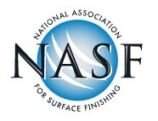The course consists of 10 lessons. Each one contains a wealth of valuable, practical information. And if you score 70 or above on the optional exam, you’ll receive 1 credit toward certification as a Master Surface Finisher. MSF is the world’s most respected – and most widely recognized – designation for finishing industry professionals. Those passing 6 course exams earn the coveted MSF designation.
Course Options
Web-Based
Dates: July: 9, 10, 16,17, 23, 24, 30, 31
Registration Deadline: June 28, 2024
Member: $1,050 | Non-Member: $1,400Home-Study
Member: $900| Non-member: $1300
Optional Exam
Member: $200| Non-member: $300
Who Benefits?
This training program was developed for operators and supervisors of wastewater pretreatment systems at contract and captive shops performing metal finishing operations such as electroplating and anodizing. The course can also benefit sales personnel who work for suppliers to the wastewater treatment industry.
Goal
The goal of this course is to provide the student with a broad range of information related to removing, neutralizing and/or destroying pollutants found in metal finishing wastewater.
- At the conclusion of this course, attendees can expect to:
- Understand the basic chemical reactions conducted in wastewater treatment.
- Be able to better understand and specify equipment used for wastewater treatment.
- Know the basic operation of pH and ORP control systems and other process instrumentation.
- Be aware of alternative methods of treatment.
- Know the impact of operational variables upon the treated effluent.
- Be aware of common problems encountered with wastewater treatment systems and possible solutions to such problems.
- Be prepared to take the examination which is part of the Foundation MSF certification program.
Course Description
- 1. Chemistry of Water, Part 1
- This is a two-part lesson detailing the relationship between chemical principles and water quality. The first part of this lesson will provide a basic background in inorganic chemistry for wastewater treatment operators, including basic chemical reactions of waste treatment. Concepts such as specific gravity, the definition of pH, acids, bases, inorganics and organics are discussed.
- 2. Chemistry of Water, Part 2
- The second part of this lesson focuses on the water molecule. Topics covered include solubility, conductivity, pH buffers, water hardness, acid base reactions and stoichiometry.
- 3. Water Quality
- This lesson details water quality issues, focusing on the conditions that affect water quality such as TOC, COD, particulates, heavy metals and non-metallic contaminants. Disinfection using UV is covered in detail, along with use of rinsing technologies that reduce water usage, making wastewater treatment systems more effective. Mass and flow balances are also briefly described.
- 4. Introduction to Wastewater Treatment
- This lesson provides information on operations and devices that are crucial to successful wastewater treatment, including pH control, ORP control, mixing, retention times and chemical feed rates. A discussion of regulations and upset response is also provided. Calculation of retention times, use of coagulants and flocculants and flow equalization are also covered.
- 5. Process Instrumentation
- This lesson covers the instrumentation measure and control used in wastewater treatment. ORP, pH, flow rate, and conductivity measurement/control are covered in detail. Also discussed are chemical metering pumps and methods of reagent addition.
- 6. REDOX Treatments
- This lesson provides detailed guidance for the most common methods of chemically treating wastes containing cyanide or chromium (+6). Batch and flow through treatments are discussed. Cyanide treatment via alkaline chlorination is a major focus of this lesson;
ozonation is also covered. Chromium reduction via reaction with a broad range of reagents is another focus of this lesson. - 7. Alternate Treatments
- This lesson covers the treatment of difficult-to-treat wastewater, such as chelated wastes. Treatments using ferrous sulfide, DTC, starch xanthate, bisulfites and other strong reducers such as borohydride are covered. A special focus is given to treatment protocols for electroless nickel and electroless copper rinses and spent solutions.
- 8. Suspended Solids Separation
- This lesson discusses flocculation, clarification, sludge thickening, and filtration of chemically treated wastewater. Gravity and parallel plate/tube type clarifier design and operational parameters are discussed along with newer technologies such as microfiltration and ion exchange systems. Sludge drying and polishing systems employed after clarification are also covered.
- 9. Carbon Treatment of Wastewater
- This lesson details the use of carbon to remove organics from wastewater that is destined to be recycled back to the plating process. Guidance as to source of carbon, powdered vs. granular, and equipment for flow-through carbon treatment of wastewater is provided.
- 10. Treatments for Oily Wastewater
- This lesson provides the generally available options for removing oily waste from wastewater. The lesson focuses on coalescing filters, dissolved air flotation, membrane-based systems, lipophilic filtration and chemical treatment followed by gravity separation.
